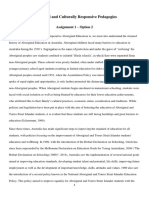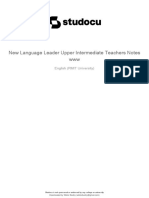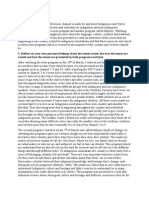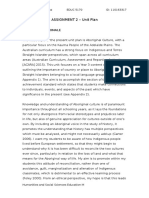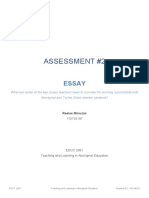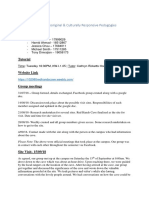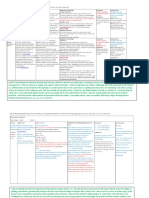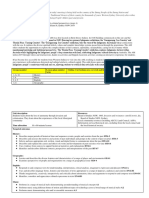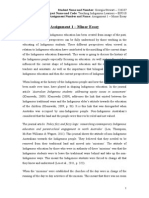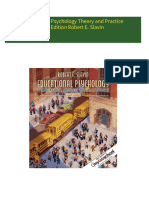14285985lauren Mcgrath
14285985lauren Mcgrath
Uploaded by
api-411050747Copyright:
Available Formats
14285985lauren Mcgrath
14285985lauren Mcgrath
Uploaded by
api-411050747Original Title
Copyright
Available Formats
Share this document
Did you find this document useful?
Is this content inappropriate?
Copyright:
Available Formats
14285985lauren Mcgrath
14285985lauren Mcgrath
Uploaded by
api-411050747Copyright:
Available Formats
Indigenous Australian Education INED3001
14285985 Lauren McGrath Page 1 of 10
Indigenous Australian Education INED3001
Critical Reflective Journal
Acknowledgment to Country
I acknowledge the Aboriginal and Torre Strait Islanders of Australia as the custodians of this land.
I pay my respects to the Indigenous people, past and present, and the elders who have passed down
knowledge for generations.
I pay respect to Indigenous and their culture that has preserved this beautiful land and seas.
I acknowledge they have lived on and respected the land for more than 40, 000 years.
I acknowledge and respect the land that we walk on today, and all the creatures that we share this
land and seas with.
I acknowledge and respect our mother Earth.
WARNING: Aboriginal and Torres Strait Island readers are warned that the following may contain
sensitive topics and the mention of deceased persons.
14285985 Lauren McGrath Page 2 of 10
Indigenous Australian Education INED3001
Introduction
Topics One to Three provided a platform to cultural awareness.
Cultural awareness and knowledge will help me include and understand my Indigenous students,
scaffold them to achieve and provide a successful learning experience (McLaughlin, 2012).
Different cultures value different learning, have different approaches to how learning is achieved and
students and teachers may play different roles in learning environments (Eberly Centre, 2015).
Third Space is the crossing of cultural borders between Indigenous and non Indigenous Australians
and encouraging understanding and compassion (McLaughlin, 2012).
By achieving Third Space (McLaughlin, 2012) I can be better support for my Indigenous students.
14285985 Lauren McGrath Page 3 of 10
Indigenous Australian Education INED3001
Topic 1 – Acknowledgment to Country
With knowledge of Indigenous history, issues and culture I can be closer to achieving Third Space
(McLaughlin, 2012). Our first Workshop discussed our experiences with Indigenous Australians. I
grew up in Armadale and my first Placement was at Yule Brook College.
Topic One introduced us to practices such as Acknowledgement To Country and Indigenous Terms Of
Reference. Korff (2016) lists 250 different languages and 600 dialects before invasion. Before this
unit I had a small understanding regarding the different areas, families and dialects however didn’t
not realise the magnitude. Teaching in Australia includes teaching students with many different
cultures and language backgrounds. Oxford University Press ELT (2010) explains teaching languages
in a classroom can build confidence and motivation in students. By including Aboriginal culture and
language in my lesson planning I can engage students and promote inclusion and comply with
Section 1.4 of the Australian Professional Standards for Teachers (AITSL, 2014).
In my practicum at Yule Brook there were clubs in which students learn Indigenous painting, song
and dance. Yule Brook participated in an Aboriginal Torre Strait Islander football club part of Clontarf
Football Academy (http://www.clontarf.org.au/). These were successful initiatives for Indigenous
students to attend school, engage and learn about Indigenous culture.
Aboriginal Terms of Reference encompass Indigenous ways of thinking, cultural procedures and
values that can be applied to a learning environment. First Contact (Blackfella Films, 2014) talks
about spiritual connection “If we don’t look after the land the land will not look after us” and Dystra
(n.d.) describes how Indigenous live with the land not off it. This knowledge brings me closer to
achieving Third Space (McLaughlin, 2012). Hein (1991) articulates that learning is contextual and we
cannot separate our learning journey from our lives. Thereby connecting content to culture would
be effective such as a land conservation activity. The Department of Education
(http://www.det.wa.edu.au/) is a good resource for lesson plans in teaching Aboriginal students.
“Behind all those ugly faces that you might see in front of you, you take this back with you and then
you might communicate differently with them … see them as people who are just trying to survive in
a different environment”,First Contact- (Blackfella Films, 2014).
Really enjoying First Contact (Blackfella Films, 2014) this quote stood out to me. Communication is
an important skill for teachers. Indigenous Australians communicate, teach and learn differently. A
collaborative classroom is more effective for Indigenous students, working together to discover
knowledge or solve a problem. I intend on having a constructivist classroom where learning is a
social activity (Hein, 1991). I believe discussion is a wonderful tool for learning. Yunkaporta (2009)
describes the social nature of sharing knowledge for Aboriginal Australians and describes how to use
these cultural differences to teach Indigenous effectively.
14285985 Lauren McGrath Page 4 of 10
Indigenous Australian Education INED3001
Understanding, respecting and using Aboriginal ways of learning will allow me to provide powerful
learning opportunities.
14285985 Lauren McGrath Page 5 of 10
Indigenous Australian Education INED3001
Topic 2 – Culture and Stereotypes
Week Two looked at how culture and stereotypes link to self-identity. Teaching Secondary Education,
due to adolescence every student is going to consider his or her self-identity. In fact the Australian
Curriculum (http://v7-5.australiancurriculum.edu.au/) includes in Health and Physical Education of
Year 9, (ACPPS089) which asks students to evaluate self-identity. Self-identity is affected by what
others think of you. I saw this on my practicum where young girls struggled with body image and
social status. The label placed on them by others affected their self-identity. Therefore I will need to
be able to lead my students in having positive outlooks.
Discussion of our own experiences with stereotypes made me recognize I am stereotyped for going
to an all girl private school, Penrhos, and also for growing up in Armadale. Both incur very different
assumptions about me. Going to Penrhos after growing up in Armadale created confusion with my
self-identity, as I felt judged for having a different family and this affected my self-confidence in
school. Today I am proud of my upbringing and this has made me empathetic, understanding, and
non-judgemental. If I can encourage my students to be proud of their roots I can encourage self-
actualisation.
Maslow’s Hierarchy (Changing
Minds, 2017) explains that higher
needs are compromised when the
lower needs are focused on. For
myself I compromised my self-
actualisation for my esteem due to
the stereotyping, I was more
worried about what people thought
of me than focusing on my own
achievements.
Looking at Indigenous stereotypes
First Contact (Blackfella Films, 2014)
reiterated that many Australians
Maslow’s Hierarchy (Changing Minds, 2017) have a negative opinion, the
workshop discussion reinforced this.
These harmful views make
Indigenous feel excluded and hold Indigenous back from achieving the fifth need, self-actualisation
(Changing Minds, 2017). Many of the negative ideas regarding Aboriginals expressed by First Contact
(Blackfella Films, 2014) were resolved with cultural understanding. Yunkaporta (2009) explains using
Aboriginal processes in the classroom can help achieve individual potential for all students this can
be achieved using strategies such as narrative, hands-on, non-verbally, modelling and scaffolding.
This can also be seen as dual coding, a strategy I personally see great value in. By doing so I can
promote cultural understanding while teaching effectively for students and hopefully resolve
stereotypes in my classroom.
14285985 Lauren McGrath Page 6 of 10
Indigenous Australian Education INED3001
As a teacher I will need to be a role model and leader to encourage positive behaviours and success.
Chris Sarra (2014) describes qualities of a leader; these qualities coincide with the Australian
Professional Standards for Teachers (AITSL, 2014). Leading students in cultural understanding and
creating programs and lessons to support this will encourage them to be more compassionate and
constructive in society (Sarra, 2014). I saw such practices at Yule Brook College, where students were
asked to reflect on their thoughts and teachers were excellent role models for such qualities.
Leading students in creating good habits, such as reflecting, are invaluable life skills that will help
students achieve.
14285985 Lauren McGrath Page 7 of 10
Indigenous Australian Education INED3001
Topic 3 – Histories and Policies
Topic three included Indigenous Australian Histories and Policies, this information leads to cultural
understanding of Indigenous learning. Robin Barrington spoke about historical wars and the ongoing
disadvantage that the Indigenous Australians face. The history regarding Aboriginals attending
schools and missionaries sheds light on these disadvantages and shows how Indigenous ways of
learning are overlooked. Originally schooled in an attempt to create a disciplined, obedient working
class, the nature of learning for Indigenous is vastly different. Yunkaporta’s (2009) shows the
different learning and teaching styles. Smith (2009) looks at Gardeners Multiple theory of
Intelligences; this theory is prime example as to how intelligence and learning can be viewed
different ways. Understanding student’s differences in learning will enable me to create effective
lessons. Thereby using different strategies, dual coding and activities in the classroom a greater
number of students can be reached. This will need to be considered in creating effective lesson
plans. Having students create mind maps for topics or making models coincides with Yunkaporta’s
(2009) model.
First Contact (Blackfella Films, 2014) discusses how these inequalities effects the Aboriginal and Torre
Strait Islanders to this day with a loss of culture and self-identity. As discussed in the previous week
having a strong positive self-identity is very important in achieving. Thereby as included in section
2.4 of the Australian Professional Standards for Teachers (AITSL, 2014) it is important for myself as a
teacher to provide opportunities for Indigenous students to learn more about their culture.
Including Indigenous communities in the students’ lives will provide improved confidence and
satisfaction of self-identity.
Many of the laws and policies created, beginning from the Aboriginal Protection Act 1869, were
regarding control of the Aborigines and rights regarding land and behaviours. The Australian
Curriculum (2014) repeats that an understanding of history is essential in creating informed and
successful future citizens. Much of the Aboriginal history has been lost as teachings are largely
verbal in the Indigenous community however this provides an opportunity to have Elders come in to
speak to students. Providing opportunity to achieve the Australian Professional Standards for
Teachers (AITSL, 2014) in creating relationships between community and family members. Having a
positive relationship with parents are carers is important in keeping a supporting and efficient
learning environment (Graham-Clay, n.d.). Yule Brook was a fantastic example of this in which
Teachers had exceptional relationships, having the phone number of every student’s parents in their
phone with constant communication. I intend on having the same Teacher-Parent relationship in the
future. Studying histories of Aboriginal and Torre Strait Islanders has made myself more informed,
appreciative of the culture and compassionate. This is the desired effect of teaching my future
students Aboriginal History. By exposing the inequalities it can generate a space in which
discrimination and racism can be looked at under a microscope. Thus accomplishing cultural
responsiveness in my classroom for my students and in turn greater societal participation (Australian
Curriculum, 2014).
14285985 Lauren McGrath Page 8 of 10
Indigenous Australian Education INED3001
Reference List
o McLaughlin. M. (2012) Crossing Cultural Borders – A Journey Towards Understanding and
Celebration in Aboriginal Australian and Non-Aboriginal Australian Contexts. Retrieved
from
http://www.ncsehe.edu.au/wp-content/uploads/2014/01/PhD-Crossing-Cultural-
Borders-Marianne-McLaughlin.pdf
o Eberly Centre. (2015). Recognize Who Your Students Are. Retrieved from
https://www.cmu.edu/teaching/designteach/design/yourstudents.html#3
o Sarra. C. (2014). Griffith Review Beyond Victims: The Challenge of Leadership. Retrieved from
https://griffithreview.com/wp-content/uploads/Chris-Sarra-Beyond-Victims.pdf
o Dystra. T. (n.d). Meaning of Land to Aboriginal People. Retrieved from
https://www.creativespirits.info/aboriginalculture/land/meaning-of-land-to-aboriginal-
people#axzz4bwHFG8RS
o Oxford University Press ELT. (2010). Teaching CLIL: Classroom Benefits. Retrieved from
https://oupeltglobalblog.com/2010/11/29/teaching-clil-classroom-benefits/
o AITSL. (2014). Australian Professional Standards for Teachers. Retrieved from
http://www.aitsl.edu.au/australian-professional-standards-for-teachers/standards/list
o Australian Curriculum. (2014). 7-10 History. Retrieved from
http://www.australiancurriculum.edu.au/humanities-and-social-
sciences/history/rationale
o Smith. M. (2009). Howard Gardner, Multiple Intelligences And Education. Retrieved from
http://infed.org/mobi/howard-gardner-multiple-intelligences-and-education/
o Korff, J. (2016). Aboriginal Languages Of Australia. Retrieved from
https://www.creativespirits.info/aboriginalculture/language/#axzz4bwHFG8RS
o Blackfella Films (Producer). (2014). First Contact [Streaming Video]. Retrieved from
http://www.sbs.com.au/ondemand/video/352505923803/first-contact-s1-ep1
o Hein, G. (1991). Constructivist Learning Theory. Retrieved from
https://www.exploratorium.edu/education/ifi/constructivist-learning
o Awaken: Indigenous Identity (2014). Retrieved from
http://www.sbs.com.au/ondemand/video/289109059808/Awaken-S2014-Ep22
o Changing Minds. (2017). Maslow’s Hierarchy. Retrieved from
http://changingminds.org/explanations/needs/maslow.htm
o Yunkaporta, T. (2009). Aboriginal Pedagogies At The Cultural Interface. Retrieved from
http://researchonline.jcu.edu.au/10974/4/04Bookchapter.pdf
o Shareourpride.org.au. (2017). Beyond the myths. Retrieved from
http://www.shareourpride.org.au/sections/beyond-the-myths/
o Cherry, K. (2016). Gardner’s Theory of Multiple Intelligences. Retrieved from
https://www.verywell.com/gardners-theory-of-multiple-intelligences-2795161
o Graham-Clay, S. (n.d.). Communicating With Parents: Strategies For Teachers. Retrieved from
http://www.adi.org/journal/ss05/Graham-Clay.pdf
14285985 Lauren McGrath Page 9 of 10
Indigenous Australian Education INED3001
Conclusion
Now equipped with a better understanding of the importance of Aboriginal history and culture, my
constructivist classroom will use multiple forms of learning.
Thus aiding Indigenous and Non-Indigenous students as I scaffold them in being culturally
competent.
I will positively affect the self-identity of my students by leading my students in having positive
relationships and habits.
14285985 Lauren McGrath Page 10 of 10
You might also like
- Kasey Cook Assessment One Literature ReviewDocument8 pagesKasey Cook Assessment One Literature ReviewKelly FrazerNo ratings yet
- Teacher Shortage Task Force Report - September 2019Document8 pagesTeacher Shortage Task Force Report - September 2019Trisha Powell CrainNo ratings yet
- Educ4132 ExamDocument17 pagesEduc4132 Examapi-357680810No ratings yet
- Assessment 1 - Purpose of Religious EducationDocument4 pagesAssessment 1 - Purpose of Religious Educationapi-140670988No ratings yet
- Texrp 2 Day Training Handouts UpdatedDocument9 pagesTexrp 2 Day Training Handouts Updatedapi-235172518No ratings yet
- EDC445 The Professional Educator A2Document9 pagesEDC445 The Professional Educator A2Maddison ParkerNo ratings yet
- Aboriginal and Culturally Responsive Pedagogies Assignment 1Document8 pagesAboriginal and Culturally Responsive Pedagogies Assignment 1api-332411347No ratings yet
- New Language Leader Upper Intermediate Teachers Notes WWW New Language Leader Upper Intermediate Teachers Notes WWWDocument205 pagesNew Language Leader Upper Intermediate Teachers Notes WWW New Language Leader Upper Intermediate Teachers Notes WWWWikiiNo ratings yet
- Edss341 Unit Plan EdfdDocument20 pagesEdss341 Unit Plan Edfdapi-455597246No ratings yet
- Lesson Plan 1 Edss428 Unit PlanDocument10 pagesLesson Plan 1 Edss428 Unit Planapi-281291423No ratings yet
- Assignment 1: Aboriginal Education (Critically Reflective Essay)Document11 pagesAssignment 1: Aboriginal Education (Critically Reflective Essay)api-355889713No ratings yet
- Edab Ass 1Document2 pagesEdab Ass 1api-298379083No ratings yet
- Howe Brianna 1102336 Task2a Edu410Document8 pagesHowe Brianna 1102336 Task2a Edu410api-521615807No ratings yet
- My Lesson FinalsDocument7 pagesMy Lesson Finalsapi-321156981No ratings yet
- The Gold Coast Transformed: From Wilderness to Urban EcosystemFrom EverandThe Gold Coast Transformed: From Wilderness to Urban EcosystemTor HundloeNo ratings yet
- 2h Reflection MurgoloDocument6 pages2h Reflection Murgoloapi-368682595No ratings yet
- Acrp ReflectionDocument4 pagesAcrp Reflectionapi-357644683No ratings yet
- Evana Loucas 110163317 Hass Assignment 2 Unit PlanDocument21 pagesEvana Loucas 110163317 Hass Assignment 2 Unit Planapi-297230954100% (2)
- Task 2 Aboriginal Pedagogies Individual ReflectionDocument6 pagesTask 2 Aboriginal Pedagogies Individual Reflectionapi-3575753770% (1)
- EssayDocument13 pagesEssayapi-361229755No ratings yet
- Academic Essay. Written Reflections & Critical AnalysisDocument4 pagesAcademic Essay. Written Reflections & Critical AnalysisEbony McGowanNo ratings yet
- Rebecca Wilman 17325509 Educ4020 Assessment 2Document5 pagesRebecca Wilman 17325509 Educ4020 Assessment 2api-314401095No ratings yet
- What Are Some of The Key Issues' Teachers Need To Consider For Working Successfully With Aboriginal and Torres Strait Islander Students?Document4 pagesWhat Are Some of The Key Issues' Teachers Need To Consider For Working Successfully With Aboriginal and Torres Strait Islander Students?api-465449635No ratings yet
- Assessment One - AboriginalDocument13 pagesAssessment One - Aboriginalapi-357662891No ratings yet
- Assessment 2 - Unit PlanDocument19 pagesAssessment 2 - Unit Planapi-519322453No ratings yet
- Aitsl Graduate StandardDocument10 pagesAitsl Graduate Standardapi-312990091No ratings yet
- Final EssayDocument6 pagesFinal Essayapi-375391245No ratings yet
- 7 2 1 - Aboriginal and Culturally Responsible PedagogyDocument6 pages7 2 1 - Aboriginal and Culturally Responsible Pedagogyapi-321023194No ratings yet
- Aboriginal Culturally Responsive PedagogiesDocument2 pagesAboriginal Culturally Responsive Pedagogiesapi-3576833510% (1)
- Acrp Essay - Assessment 1Document13 pagesAcrp Essay - Assessment 1api-368764995No ratings yet
- Acrp Assessment 2 EssayDocument9 pagesAcrp Assessment 2 Essayapi-533984328No ratings yet
- Aboriginal Assignment 1 FinalDocument10 pagesAboriginal Assignment 1 Finalapi-357661397No ratings yet
- 2h2018assessment1option1Document10 pages2h2018assessment1option1api-432307486No ratings yet
- Humanities Unit Planner Eeo311Document12 pagesHumanities Unit Planner Eeo311api-313139874100% (3)
- Individual Reflection 17456933Document6 pagesIndividual Reflection 17456933api-518663142No ratings yet
- Assignment 1 - 102085Document10 pagesAssignment 1 - 102085api-357692508No ratings yet
- Standard 2 4 EvidenceDocument8 pagesStandard 2 4 Evidenceapi-324752028No ratings yet
- 2h 2018 Assessment1 Option2Document7 pages2h 2018 Assessment1 Option2api-355128961No ratings yet
- Aboriginal and Culturally Responsive PedagogiesDocument7 pagesAboriginal and Culturally Responsive Pedagogiesapi-379378935100% (1)
- Aimee Eberhard Assignment 3Document6 pagesAimee Eberhard Assignment 3api-371539409No ratings yet
- Aboriginal and Culturally Responsive Pedagogies Assessment 1Document9 pagesAboriginal and Culturally Responsive Pedagogies Assessment 1api-321128505No ratings yet
- Klaryse Dam - Essay On The Foundation of Teaching and LearningDocument12 pagesKlaryse Dam - Essay On The Foundation of Teaching and Learningapi-505539908No ratings yet
- Assignment 3 Hass Unit PlanDocument8 pagesAssignment 3 Hass Unit Planapi-626567329No ratings yet
- Educ4720 - Assignment 3Document7 pagesEduc4720 - Assignment 3api-479855637No ratings yet
- Unit 102082 Philosophy of Classroom Management Document R 1h208Document17 pagesUnit 102082 Philosophy of Classroom Management Document R 1h208api-374359307No ratings yet
- Edfd452 Evidence - Edss341 A3Document21 pagesEdfd452 Evidence - Edss341 A3api-358837015No ratings yet
- Rimah Aboriginal Assessment 1 EssayDocument8 pagesRimah Aboriginal Assessment 1 Essayapi-376717462No ratings yet
- E Portfolio Evidence Standard 3 4 and 5Document13 pagesE Portfolio Evidence Standard 3 4 and 5api-287660266100% (1)
- Aboriginal Education Essay2 FinalDocument5 pagesAboriginal Education Essay2 Finalapi-525722144No ratings yet
- Unit Outline 102085Document17 pagesUnit Outline 102085api-406108641No ratings yet
- Wilman Rebecca 17325509 Educ4001 Assessment 2Document15 pagesWilman Rebecca 17325509 Educ4001 Assessment 2api-314401095100% (1)
- Philosophy of Classroom Management 18918928 2h 2017Document24 pagesPhilosophy of Classroom Management 18918928 2h 2017api-356533687No ratings yet
- 2h2018assessment1option1Document9 pages2h2018assessment1option1api-317744099No ratings yet
- Assessment 2Document14 pagesAssessment 2api-297389221No ratings yet
- Hsie Professional TaskDocument23 pagesHsie Professional Taskapi-460543617No ratings yet
- Pple Assessment 2 Kamil James 16525694Document26 pagesPple Assessment 2 Kamil James 16525694api-321112414100% (1)
- Howe Brianna 1102336 Task1 Edu202Document8 pagesHowe Brianna 1102336 Task1 Edu202api-457440156No ratings yet
- Assignment 1Document5 pagesAssignment 1api-279841419No ratings yet
- EDFD462 Personal Professional Learning PlanDocument5 pagesEDFD462 Personal Professional Learning PlanClaudia YoussefNo ratings yet
- Assessment 1: Aboriginal Education: Reflective EssayDocument8 pagesAssessment 1: Aboriginal Education: Reflective Essayapi-332298416No ratings yet
- Aboriginal EssayDocument5 pagesAboriginal Essayapi-428484559No ratings yet
- AboriginalDocument9 pagesAboriginalapi-357683351No ratings yet
- Stakeholders in EducationDocument4 pagesStakeholders in EducationRizwan AhmedNo ratings yet
- Module 1 1Document44 pagesModule 1 1Lecel MartinezNo ratings yet
- The Need For Inclusivity in Nigerian Higher Education SystemDocument6 pagesThe Need For Inclusivity in Nigerian Higher Education SystemKIU PUBLICATION AND EXTENSIONNo ratings yet
- Let 24Document31 pagesLet 24Hanima S. DaudNo ratings yet
- SDO Camarines Norte: Facilitating Dreams, Valuing AspirationsDocument6 pagesSDO Camarines Norte: Facilitating Dreams, Valuing AspirationsZyra CabarleNo ratings yet
- Year 4 Daily Lesson Plans: By:MissashDocument5 pagesYear 4 Daily Lesson Plans: By:MissashAineey ZainNo ratings yet
- Şimşek, H., Yıldırım, A.Turkey - Innovation and Tradition-Book ChapterDocument31 pagesŞimşek, H., Yıldırım, A.Turkey - Innovation and Tradition-Book ChapterEsra GülsünNo ratings yet
- Core Behavior Competencies OPCRFDocument19 pagesCore Behavior Competencies OPCRFMisyel CamposanoNo ratings yet
- B.P. Ed Physical Education1 PDFDocument68 pagesB.P. Ed Physical Education1 PDFVedant 23 GoogleNo ratings yet
- Narrative Report (TEACHING)Document9 pagesNarrative Report (TEACHING)Angelie Selle A. GaringanNo ratings yet
- WebinarDocument79 pagesWebinarRose MayNo ratings yet
- Module 4 The Teacher As A Person in SocietyDocument4 pagesModule 4 The Teacher As A Person in SocietyJaafar SorianoNo ratings yet
- Article 2Document7 pagesArticle 2Marinel VillaneraNo ratings yet
- Tle-9-Techniques in Carrying Plates and AshtraysDocument4 pagesTle-9-Techniques in Carrying Plates and AshtraysGrace CumamaoNo ratings yet
- Benchmark Race RelationsDocument8 pagesBenchmark Race RelationsRaymond BartonNo ratings yet
- Domain 1 Evidence and Reflections BlankDocument7 pagesDomain 1 Evidence and Reflections Blankapi-544209102No ratings yet
- Download Full Educational Psychology Theory and Practice 8th Edition Robert E. Slavin PDF All ChaptersDocument55 pagesDownload Full Educational Psychology Theory and Practice 8th Edition Robert E. Slavin PDF All ChaptersshirkohumpelNo ratings yet
- Kindergarten Information 2016 1Document7 pagesKindergarten Information 2016 1api-308347282100% (1)
- TPACK Proficiency of The International Teachers in China: Basis For Intervention ProgramDocument7 pagesTPACK Proficiency of The International Teachers in China: Basis For Intervention ProgramPsychology and Education: A Multidisciplinary JournalNo ratings yet
- C Mcfarlane Etec521 Final PaperDocument15 pagesC Mcfarlane Etec521 Final Paperapi-229016896No ratings yet
- GRADES 1 To 12 Daily Lesson Log: ST ST ST ST STDocument5 pagesGRADES 1 To 12 Daily Lesson Log: ST ST ST ST STErnita Corpuz Raymundo0% (2)
- Pe3 Report ExtractDocument1 pagePe3 Report Extractapi-296157141No ratings yet
- Division Memorandum No. 1 s.2017 PDFDocument14 pagesDivision Memorandum No. 1 s.2017 PDFAujj hshHNo ratings yet
- School Family and Community PartnershipsDocument66 pagesSchool Family and Community PartnershipsCornelia DinescuNo ratings yet
- Sociology of Education An A To Z Guide 1st Edition James Ainsworth All Chapter Instant DownloadDocument62 pagesSociology of Education An A To Z Guide 1st Edition James Ainsworth All Chapter Instant Downloadprabirhuiyee100% (3)
- Greetings - OkDocument6 pagesGreetings - OkchristieNo ratings yet
- A Premium Education House: Investor PresentationDocument36 pagesA Premium Education House: Investor Presentationhimir.shahNo ratings yet






